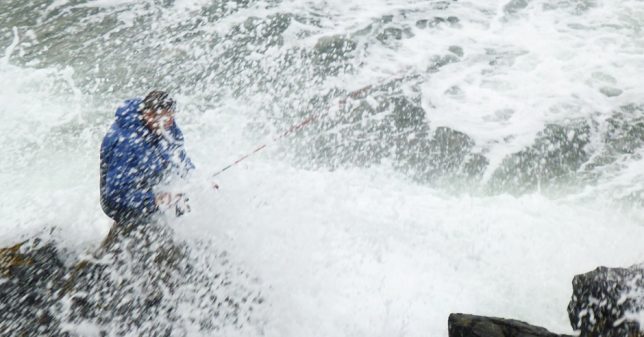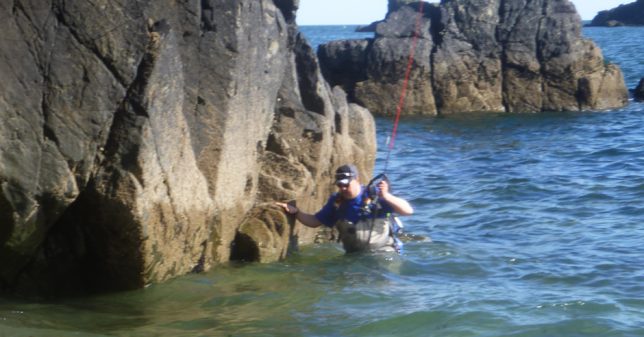Bass Fishing Safety
General awareness
As bass anglers we have chosen a sport that brings us into contact with ‘the great outdoors’, but with that comes a responsibility for our own safety, and for how our actions might affect the safety of others.
It’s wise to develop a basic instinct for safety when bass fishing, so here are some general guidelines. It’s not a complete list – to write such a list that would be impossible because of the wide range of places and conditions that provide us with our bass fishing.
Overall, there is a superb guidance booklet issued by the RNLI: ‘Sea Safety – The Complete Guide’. It appears to be written for boat users, but it has a wealth of information for all water users. Please do have a look at it and adapt it to your own fishing and the places that you fish.

Clothing
Wear clothing suitable for the terrain and the expected weather. This sounds obvious, but good information is out there, such as on the BASS Forum regarding waders and wading boots. Learn and understand the fundamental difference between a life jacket and a buoyancy aid, and if you are contemplating buying one, make the right decision as it could literally cost you your life if you get it wrong. If you haven’t watched Henry Gilbey’s videos on this subject, that he made in conjunction with the RNLI, please do – they are a real eye-opener and I guarantee you’ll see how important and relatively inexpensive these are.
Tide, waves and currents
Get to understand the power of waves, undertows and currents for the venues that you fish, and how they can affect your safety. If you are unsure, go with someone who knows, and learn from them. There’s no need to try and keep up with them, just follow their example and learn the little things that they have learnt over time.
Learn and understand the conditions for a rip current, and be aware of the basic way of dealing with one if you are ever unfortunate enough to be in one. There is far more information on the dangers of rip currents on surfing websites and some very good videos on them.
On average, 350 people drown in the UK each year and just over 25% of those who drown are anglers. That’s 80 to 90 anglers who probably thought that it could never happen to them.
Ground conditions, and use of a wading staff
Be careful on uneven, unstable or soft ground. When I say ‘unstable’ I mean stepping onto a small chunk of rock that’s under the surface, but topples when you put your weight on it; if this happens just let your foot go down to the next ‘level’. If that just doesn’t happen, then you need to use your rod as a steadying prop. This all happens occasionally – it’s because everything weighs less when under water, even a piece of rocks and so it is wise to go fishing in company in case one of you has a stumble.
A wading staff can help with your balance in such circumstances. It doesn’t need to be anything fancy or expensive. (I still have a walking stick of the ‘Winston Churchill’ type, which has a lanyard tied to it, the other end of the lanyard having a dog-lead clip which clips onto a D-ring on my coat. When I’m wading and fishing, I let the stick and lanyard float behind me.)

Local information
Seek out local information from reliable sources, and use it wisely. The same goes for the local weather forecast and tide times. The Magic Seaweed website is probably the most commonly used and accurate forecast for tide and wave conditions.
Casting safely
For those who bait fish, we sometimes need to fish at a distant area of ‘structure’ such as a gulley or a previously-known large rockpool. This can require the use of a beachcaster rod and a shock leader at the end of the reel line, to absorb the acceleration of the lead at the start of the cast, otherwise the reel line will easily break during the cast. The general rule of thumb is that the shock leader breaking strain should be 10lb for each ounce of weight cast, and its length should be about 6 times round the spool plus the length of the rod.
Don’t power cast when there are other people nearby. The momentum of the lead can kill.
Health hazards
Fishing around sewage outfalls is generally a thing of the past for shore anglers, but some sewage is still piped out to sea at specific places, discharging well away from public beaches etc. It’s best to keep clear of such places – whether you are on foot or out in a boat or kayak – the mullet anglers might prefer such places but there is plenty of choice in bass fishing, so it’s not worth taking chances with your health.
Also don’t fish when there is lightening forecast in the area. A rod made of modern carbon composite can and will act like a lightening conductor with possibly fatal consequences.
Have a strategy
If someone takes you out on their boat, listen to what they say about safety, and take heed. They are ultimately responsible, but never think that they will do it all – they might, just might, one day have to rely on you to do something they told you.
I used to fish with a very good angler on all sorts of rocky terrain. With him having sporting injuries and me being a non-swimmer (I’m not scared of water), we had a strategy – if one of us has an accident and is unable to walk, then:
1) the other gets him to a reasonable place of safety above the high water mark, and
2) the other goes for help, or goes to find a phone signal to then get help!
Your strategy doesn’t have to be the same, but it’s worth chatting with your angling buddy about such things and making a plan. Precautions, such as telling someone where you intend to fish and your anticipated time of return, or carrying a VHF radio or mobile phone are good practice and nowadays, apps such as what3words, can narrow down the search area for the rescue services, so it makes sense to have this on your phone before you go fishing.
And now the good news
You now know a few things about bass fishing safety. Keep them in mind and above all – stay safe!
Author: Geoff Gonella / Steve Pitts
Photos: Steve Pitts
© Bass Anglers’ Sportfishing Society 2021